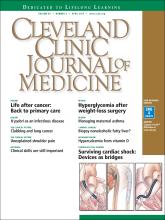Article Figures & Data
Tables
Maternal effects
Preeclampsia
Pregnancy-induced hypertension
Gestational diabetes
Premature rupture of membranes
Cesarean birth
Chorioamnionitis
Hyperemesis
Postpartum hemorrhageFetal effects
Perinatal death
Preterm birth
Low birth weight
Intrauterine growth restriction
Congenital malformations
Admission to neonatal intensive care unit
Hyperbilirubinemia
Respiratory distress syndrome
Transient tachypnea of the newborn
Asphyxia
Increased risk of intracerebral hemorrhage, anemiaBased in part on information in reference 9.
Minimal or no chronic symptoms day or night Minimal or no exacerbations No limitation on activities Maintenance of normal or near-normal pulmonary function Minimal use of short-acting beta-agonists Minimal or no adverse effects from medications Based on information in reference 12.
Drug Categorya Short-acting beta-agonist Albuterol C Long-acting beta-agonists Formoterol C Salmeterol C Inhaled corticosteroids Budesonide (inhalation) B Fluticasone (inhalation) C Leukotriene modifiers Montelukast, zafirlukast B Zileuton C Monoclonal antibody Omalizumab B Xanthine derivative Theophylline C Intranasal corticosteroids Intranasal budesonide B Intranasal fluticasone C Intranasal mometasone C Intranasal triamcinolone C ↵a Former US Food and Drug Administration risk category (see Drugs, this page).
Monitor to ensure the maternal oxygen saturation remains above 95% Consider systemic (oral) corticosteroids Administer rescue therapy with a short-acting beta-agonist Consider hospital admission if symptoms do not improve with emergency room care Consider admission to intensive care unit and mechanical ventilation if symptoms are severe or if patient shows signs of impending respiratory failure Carefully monitor fetal health






